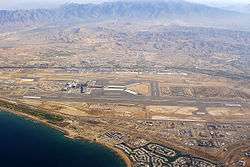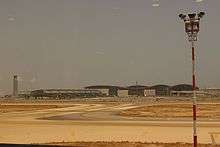Muscat International Airport
| Muscat International Airport مطار مسقط الدولي | |||||||||||||||
|---|---|---|---|---|---|---|---|---|---|---|---|---|---|---|---|
 | |||||||||||||||
| IATA: MCT – ICAO: OOMS | |||||||||||||||
| Summary | |||||||||||||||
| Airport type | Military/Public | ||||||||||||||
| Operator | Oman Airports Management Company | ||||||||||||||
| Serves | Muscat | ||||||||||||||
| Location | Muscat, Oman | ||||||||||||||
| Hub for | Salam Air | ||||||||||||||
| Coordinates | 23°35′18.92″N 58°17′26.16″E / 23.5885889°N 58.2906000°ECoordinates: 23°35′18.92″N 58°17′26.16″E / 23.5885889°N 58.2906000°E | ||||||||||||||
| Map | |||||||||||||||
 MCT Location of Airport in Oman | |||||||||||||||
| Runways | |||||||||||||||
| |||||||||||||||
| Statistics (2015) | |||||||||||||||
| |||||||||||||||
Muscat International Airport (IATA: MCT, ICAO: OOMS), formerly Seeb International Airport,[1] is the main international airport in Oman. It is situated 32 km from the old city and capital Muscat within the Muscat metropolitan area. The airport serves as the hub for flag carrier Oman Air and features flights to several regional destinations as well as some intercontinental services to Europe and Asia.
History
The airport opened as Seeb International Airport in 1973, replacing a smaller airfield located in Bayt al Falaj.[2]
It has hosted Royal Air Force BAe Nimrods in the past, including for the 1991 Gulf War. These aircraft cooperated with the Royal Navy of Oman in the 'Magic Roundabout' exercise series.[3] The base was used by a detachment of Vickers VC10 tankers from No. 101 Squadron RAF during the Gulf War training with Royal Air Force SEPECAT Jaguars.[4]
As of 1 February 2008, the airport's name has been changed from Seeb International Airport to Muscat International Airport.[1]
Facilities
The entire airport is spread over an area of 21 square kilometres (8.1 sq mi). It originally featured one passenger terminal building, one runway as well as minor cargo and maintenance facilities and is currently undergoing a major extension and replacement consisting of a second runway, an entirely new passenger terminal and a new control tower.
Current Terminal
The airport currently features one single, two-storey passenger terminal. It has a T-shape and is equipped with 58 check-in counters, 23 departure gates, 3 baggage reclaim belts and some service counters and shops.[5] The building, dating from the 1970s, has been expanded several times during the last years to cater for growing passenger numbers.[5] However, it still has no aircraft stands equipped with jet-bridges, therefore bus-boarding is used for all operations. The existing terminal will be renamed to "Terminal 2" once the new terminal becomes fully operational and will handle low-cost flights.
Future Terminal
The current terminal will be replaced with an entirely new and significantly larger state-of-the-art facility to the north of the existing terminal and first runway. This new building, which is under construction as of September 2016, will initially bring the airport's capacity up to 12 million passengers a year upon completion of the first phase.[6] Subsequent enlargements under second and third phases will increase the airport capacity to 24 and 48 million annual passengers respectively.[6] The first stage will cover 580,000 sqm and will feature 86 check-in counters, 10 baggage reclaim belts, 29 aircraft stands with jet-bridges as well as a new control tower. The new terminal is located between the old and new runways and will be able to handle large aircraft like the Airbus A380 and the Boeing 747.[7] Once the new terminal is completed and becomes fully operational, the existing terminal will be used for low-cost carrier operations.
Runways and apron
The airport used to have a single runway. As of September 2016, a second newly built runway is already in use to the north of the new terminal building which can handle big airplanes such as the Boeing 747-8 and the Airbus A380 while the older one between the new facilities and the current passenger terminal is closed for refurbishment[8] as part of the construction of the entirely new main terminal building and apron area. The current apron features 32 stands[5] on both sides of the T-shaped passenger terminal building with 30 new ones being constructed in two phases[7] in front of the new terminal building of which several are already in use as of September 2016. The airport is capable of handling wide-body aircraft up to the size of a Boeing 747-8.
Airlines and destinations
Passenger
The following airlines operate regular scheduled and charter flights to and from Muscat:[9]
.jpg)
.jpg)

.jpg)
Cargo
| Airlines | Destinations |
|---|---|
| Cargolux | Chennai, Hong Kong, Luxembourg, Mumbai |
| DHL Aviation | Dubai-International |
Statistics
| Year | Total passengers | Total Freight including Mail in Tons | Total Civil Aircraft movements |
|---|---|---|---|
| 2015 | 10,314,449[14] | N/A | 94,920[14] |
| 2014 | 8,709,505[15] | N/A | 82,085[15] |
| 2013 | 8,310,927 | 120,040 | 81,244 |
| 2012 | 7,546,715 | 113,269 | 73,842 |
| 2011 | 6,479,860 | 98,780 | 68,696 |
| 2010 | 5,751,516 | 96,390 | 67,160 |
| 2009 | 4,556,502 | 64,419 | 55,330 |
| 2008 | 4,002,121 | 58,486 | 45,600 |
| 2007 | 4,220,429 | 77,292 | 45,655 |
| 2006 | 4,777,747 | 99,529 | 46,319 |
Access
The airport is located near the Sultan Qaboos Highway between Muscat and Seeb. Taxis, car hire and chauffeur services are available. Public buses stop in front of the airport area on the highway.[16]
References
- 1 2 https://www.omanairports.co.om/Page.aspx?MID=38&PGID=21
- ↑ "Airport History". Oman Airports Management Company. Retrieved 24 October 2012.
- ↑ Gp Capt Brian Burridge, Royal Air Force Nimrods in the Gulf
- ↑ "19 Years Over Iraq". The Official RAF Annual Review 2010. Stamford: Key Publishing: 9. December 2010.
- 1 2 3 omanairports.co.om - Airport Development retrieved 30 September 2016
- 1 2 http://www.bechtel.com/projects/oman-airport-expansion-muscat/
- 1 2 omanairports.co.om - New Airport Development retrieved 30 September 2016
- ↑ "Pilot information for Muscat international Airport". Our Airports. Retrieved 5 February 2015.
- ↑ omanairports.co.om - TimeTable retrieved 23 July 2016
- ↑ IndiGo https://www.goindigo.in/information/new-flights.html. Retrieved 28 October 2016. Missing or empty
|title=(help) - ↑ "KLM S17 Middle East Service Changes". Airlineroute. Retrieved 24 November 2016.
- ↑ "Oman Air delays Guangzhou launch to Dec 2016". Retrieved 11 August 2016.
- ↑ http://www.routesonline.com/news/38/airlineroute/269890/oman-air-schedules-manchester-launch-in-may-2017/
- 1 2
- 1 2
- ↑ omanairports.co.om - Transportation from/to Muscat International Airport - Muscat Airport retrieved 23 July 2016
External links
![]() Media related to Muscat International Airport at Wikimedia Commons
Media related to Muscat International Airport at Wikimedia Commons